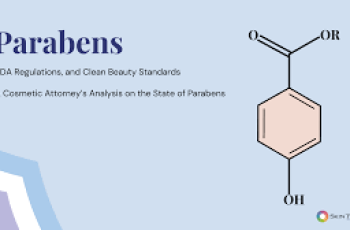
Can I use mandelic acid during pregnancy?
Pregnancy is always a special time. Every day can be a rollercoaster of emotions, and focusing on preparing for the arrival of your little bundle of joy can be overwhelming. But that doesn’t mean you should let stress take over. Instead, take the time to make sure you still have time to take care of yourself and give yourself some well-deserved pampering time.
I recommend all moms-to-be to get regular pampering. I also want to encourage you to be mindful of your safety. So always make sure the product formulations and active ingredients you put on your skin are appropriate, safe, and avoid adverse reactions. This brings us to the topic of today’s blog post, which is whether or not mandelic acid can be used during pregnancy. So without further ado, let’s dive in to find out more.
What is mandelic acid?
Derived from bitter almonds, mandelic acid is one of the lesser-known members of the alpha hydroxy acid family. Although there hasn’t been enough research done on it, mandelic acid is still considered one of the gentlest AHAs and can help with a number of issues. The reason mandelic acid is so gentle on the skin is because it has a larger molecular size than other acids, such as B. glycolic acid, which means it can’t penetrate too deeply into the skin, which can cause irritation.
Some studies even suggest that mandelic acid is highly effective in fighting skin problems, and is even considered more effective than salicylic acid in treating inflammatory conditions such as pimples and other breakouts. One study showed that using a chemical peel containing 45% mandelic acid was more effective than using another peel containing salicylic acid.
Skincare Benefits of Mandelic Acid
Exfoliates the outer surface of the skin, removing excess oil, dead skin cells, dirt, and bacteria. This not only leaves a clear, glowing complexion, but also reduces the likelihood of acne and other breakouts.
By shedding dead skin cells, the skin texture feels smoother and firmer.
Mandelic acid can stimulate collagen production, plumping and firming the skin and reducing fine lines and wrinkles.
Areas of hyperpigmentation, such as dark spots or signs of melasma, can be significantly reduced.
Mandelic acid is rich in antioxidants, which can protect against free radical damage, such as UV rays, pollution, central heating, and other environmental aggressors.
You can find out more about mandelic acid and its effects on the skin in our Skin School.
What products should I avoid during pregnancy?
In addition to the foods and drinks that should be avoided during pregnancy, there are some skin care products and ingredients that should also be avoided.
Retinol, Retinyl A, and Retinyl Palmitate
Vitamin A and all its derivatives should be completely avoided during pregnancy and postpartum until the end of breastfeeding. This is due to possible complications with the baby’s development and birth defects.
Salicylic Acid and Benzoyl Peroxide
Acne breakouts are a common side effect of pregnancy. Many people like to use salicylic acid or benzoyl peroxide, but they are too strong for the skin during pregnancy and should be avoided. If you are having trouble controlling your acne breakouts, it is best to consult a doctor or dermatologist to find the best option for you and your skin.
Some other ingredients that should not be used during pregnancy include:
Essential oils
Hydroquinone
Formaldehyde
Aluminum chloride
Chemical sunscreens
Dihydroxyacetone
Tetracycline
If you find that you already have these ingredients in your daily routine, stop using them as soon as you know you are pregnant. I also recommend that you consult your doctor to ensure that you adopt the best daily habits to keep you and your baby safe.
When shouldn’t you use mandelic acid?
You shouldn’t use mandelic acid if you want to apply retinol to your skin at the same time. This is too much exfoliation and can put too much stress on the skin, causing it to dry out and become irritated. By over-exfoliating, you also remove sebum from your skin, the natural oil on the surface of your skin. This can cause your skin to become unbalanced, which can lead to excessive sebum production, causing your skin to become increasingly oily and causing rashes, acne, and other blemishes.
If you want to use mandelic acid and retinol in your daily routine, it’s best to alternate between these two powerful substances. By avoiding applying them one after the other, you can give your skin enough time to absorb them and rebalance its pH levels, allowing your skin to reap the benefits without unnecessary dryness or irritation.
Is mandelic acid safe to use while breastfeeding?
Yes, mandelic acid is safe to use while breastfeeding. This is because the acid’s larger molecular size means it doesn’t penetrate the skin as strongly as other stronger acids, such as glycolic and salicylic acids.
If you’re unsure or nervous about using a skincare formula, especially if it’s new, it’s best to consult your doctor before applying anything to your skin.
What skincare products can I use during pregnancy?
There are several dedicated brands that have developed specialized products that moms-to-be can use with peace of mind. However, if you’re just thinking about changing a few things in your existing routine, you must first understand that your skin goes through some changes during pregnancy. Some of the most common skin issues that can occur during pregnancy include dry skin, melasma and hyperpigmentation, and acne flare-ups. If you already have a skin condition like eczema, psoriasis, or rosacea, your condition may temporarily worsen during the first trimester.
Here’s more information on using mandelic acid during pregnancy. Don’t forget to visit us on Instagram if you have any additional questions.


